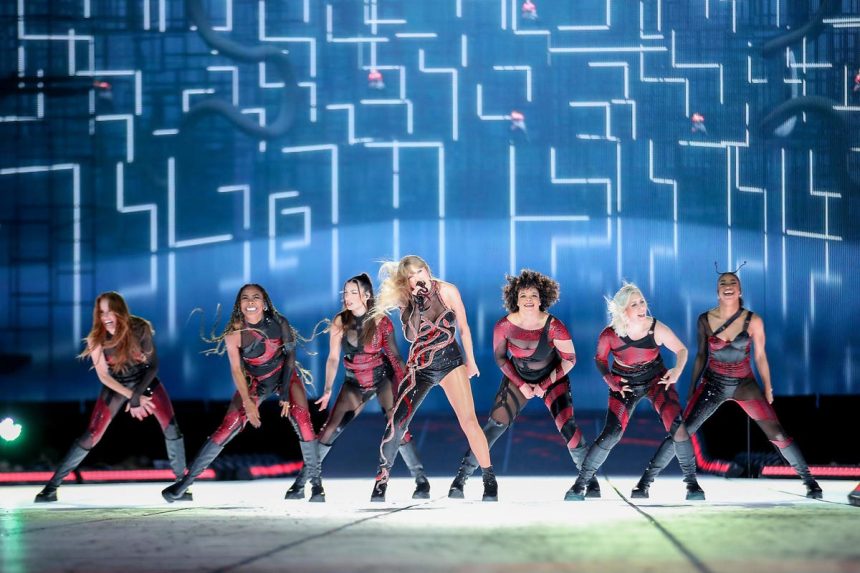The earth literally moved when Swifties at the Taylor Swift concert in Seattle, Washington last weekend. The seismologists at Western Washington University detected a 2.3 magnitude earthquake adjacent to where her concert was at Lumen Field. That’s emblematic of the power of culture to shift the ground beneath our feet – and maybe beneath our habits.
Movies, ads, art, books and music have the power to move us, sometimes profoundly, causing a cultural earthquake. “Jaws” did, as did “E.T.”, “Philadelphia,” Andy Warhol’s art, the Live Aid concert in 1985 that raised $127 million for famine relief in Africa, the televised McCarthy hearings and Watergate hearings and January 6th hearings, “Succession,” and the mushroom cloud commercial from Lyndon Johnson’s 1964 presidential campaign that resonates today in the movie “Oppenheimer,” to name a few.
“For anything to happen on a grand scale, we need to have culture supported,” Chantal Bilodeau, Founder of the Climate & Arts Initiative, explained in an exclusive interview on Electric Ladies Podcast. “Artists are good at planting these seeds, putting the stories out there and for anybody. The key is repetition. So, if you encounter a certain story, certain type of story, in the music you listen to, in the articles that you read, in the billboard that you see or the murals that you see when you walk down the street, at some point, it creates a frame that you can start to live in and the changes become something that is natural.”
Will the writers and actors on strike reflect on how to use their power as storytellers?
As writers and actors’ strikes force the entertainment industry to pause, reflect and negotiate, maybe, just maybe, they can also consider how to use the power of their mediums to educate, motivate and engage their audiences on how the technologies, habits, and products that address climate change enable us to maintain the lifestyle to which we have become accustomed or make our lives more efficient, safer, healthier or more fun.
When will Hollywood talk about or integrate them into their scripts? Like characters going on a date in an electric car, showing the actors plugging it in to recharge wherever. Or, clothing shopping and asking the store clerk for items made from sustainable fabrics like Tencel or the new Levi’s 501s made from organic cotton, recycled materials and less water. Or, maybe have the characters advocating for adding trees and parks to cool our cities and reduce carbon emissions, or working in clean energy technologies. That’s what some in the Hollywood ecosystem hope.
“I think we’re unfortunately in a media environment where it’s really skewed toward covering all of the tragedy that we’re experiencing. And there’s so much to be hopeful about and so much to look for in terms of the solutions that are being enacted,” Jill Tidman, Executive Director of The Redford Center, told me in an exclusive interview (airing in September on Electric Ladies Podcast). The Redford Center is an independent nonprofit founded by actor, filmmaker Robert Redford and his late brother James that is dedicated to “advancing environmental solutions through the power of stories that move,” according to their website.
Stories that show resilience, community power, courage and creative solutions – especially wins
Just as they flood our screens with violence and action movies, Hollywood could use its power to model nonviolent solutions and advocating for the environment, just like “Law & Order SVU” advocates for rape victims and shows victims’ rights. Tidman said the Redford Center supports stories that raise awareness, educate and “that gives other people a lot of hope.”
Tidman said, “the number one thing” they look for, “is seeing other people showcase moral courage and strength,” in doing something about “a situation that’s really unfair, unjust, incredibly impactful.” One example she cited a documentary about a community battling a manufacturing company that’s been polluting their community’s resources for years, causing a range of cancers. The woman telling the story is battling cancer as well.
“Sometimes a project in and of itself, just the awareness of an issue can be part of the solution,” she added. Another one they supported is called “Deep Rising,” about the environmental, social, geopolitical and economic dangers of impending commercial mining of ocean beds for metals that are critical for the energy transition, including nickel and cobalt. (The International Seabed Authority recently delayed their final regulations to better evaluate all these issues due to complaints.)
Another project that’s quite creative, increases awareness and demonstrates moxie and agency is “Youth v. Gov,” which is also in the news these days. It’s about a group of 21 young plaintiffs (ages 14-24) who are suing the federal government for putting their rights at risk by not addressing climate change. On June 1, 2023, U.S. District Judge Ann Aiken moved the case towards trial, saying “Exercising my ‘reasoned judgment,’ I have no doubt that the right to a climate system capable of sustaining human life is fundamental to a free and ordered society.”
Showing people – and real or fictional – taking positive action to address climate change and benefit from doing so (legally), helps give the audience a sense of their own ability and responsibility to take action too, according to Tidman.
“This is everyone’s issue”
A lot of people have shifted, Tidman told me, from denial to “it’s not my problem, I don’t have to deal with it because there’s so much activity going on.” But she and The Redford Center believe “it’s everyone’s issue.”
Creatives have a unique skillset they could use to reach people through narrative storytelling, in a range of different situations, to reach millions of people on a level that other industries cannot.
“This is everyone’s issue,” Tidman emphasized, “And so, how can we bring more people in in a way that they can start to see this as something that does affect them, whether they want it to or not, or whether they recognize it or not?”
Read the full article here






